|
< Earlier Kibitzing · PAGE 3 OF 3 ·
Later Kibitzing> |
| Jan-17-14 | | hedgeh0g: <mike1> Maybe, but it certainly looks very risky. With the locked queenside structure on a favourable colour complex, Black essentially has an extra passed pawn and a superior bishop to work with. |
|
| Jan-17-14 | | SirRuthless: <mike1> Not convinced that is a draw he is trading of a good bishop for a decent knight and in that version black would have a good bishop vs bad white bishop notice the color of the pawns relative to the bishops. |
|
| Jan-17-14 | | Moszkowski012273: Naka missed a few stronger moves at the end here... Still well played though. |
|
| Jan-17-14 | | morfishine: Black has an edge with two Bishops and White's pinned Knight. To keep the edge, Black must threaten to win material; otherwise, White can hold the balance by unpinning the Knight (55.Kb2) threatening 56.Nxg5. So, my initial candidates are 54...Rd4, 54...Bb4 & 54...Be3; However, all can be met by 55.Rd1 There must be a 4th candidate. Other than 54...e5 I don't see any useful pawn moves except for possibly the break with 54...g4 (4) <54...g4> 55.hxg4 h3 56.gxh3 Rf8 57.Kd3 Rf4 and curiously, White is lost (4a) However, better for White is <56.Rd1> 56...h2 57.g3 Rf8 58.Bh1 Rf2+ 59.Kd3 Rb2 60.Kc3 and White is barely hanging on; But in fact, Black has better all along: (4b) 54...g4 55.hxg4 h3 56.Rd1 Rh8 57.gxh3 Rxh3 58.Bh1 Re3 and Black wins a piece *****
PM: I feel satisfied to have come relatively close with continuation 4b *****
<perfidious> Thanks for reminding of us this famous game: Korchnoi vs Tal, 1962 ***** |
|
| Jan-17-14 | | Cheapo by the Dozen: I can't come up with anything better than
54 ... g4
55 hg h3
56 gh Rf8 winning a piece.
Or if White refuses the second pawn (taking the first one is forced) with 56 Re1 or 56 Kc3, then Bxe4/h2/Bg1/Rh8/h1 looks very hard to stop. 56 Rd1 is even worse. |
|
| Jan-17-14 | | Cheapo by the Dozen: Oops. I miscalculated what happens after Rd1. Tough position over all. |
|
| Jan-17-14 | | kevin86: Black's bishop and pawn trap white's rook like a bug in a rug. |
|
Jan-17-14
 | | Jimfromprovidence: I thought that black could have continued with 56...h2 directly, as the text 57 Rf8 allows for 57...Kc3!?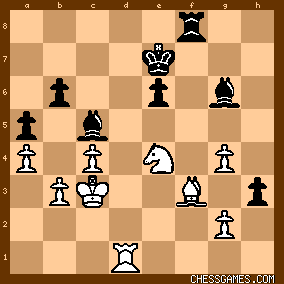
click for larger viewNow the pin is off of the knight and white makes black think. Do I take the knight right now or play ...h2? if he plays 57...h2, then white has 58 Nxc5 so after 58...bxc5 the passed pawn is no longer as big of a threat. 
click for larger view |
|
| Jan-17-14 | | Pnice: Subtle Sneak attack, I seen it, but couldn't see why h3 was the follow up after g4. I am assuming 56...Rf8 would of followed 56.gxh3? Is that right? |
|
Jan-17-14
 | | ajk68: What does black do if
54... g4 55. hxg4 h3 56. Rh1, ?
If 56...Rd4 57. Rd1 h2 58. g3 and I don't see anything for black. |
|
| Jan-17-14 | | PJs Studio: Is 57. Kc3 any better? |
|
| Jan-17-14 | | independentthinker: After 54 ... Rf8 and 55 Kc3 why can't black just capture the knight and win a piece? |
|
| Jan-17-14 | | RedShield: Before answering that you have to ask: why would you play 55.Kc3? |
|
Jan-17-14
 | | Jimfromprovidence: <independentthinker> <After 54 ... Rf8 and 55 Kc3 why can't black just capture the knight and win a piece??> I assume that you meant that white would play 55 Kd3. Nevertheless, what happens after 54...Rf8 deserves attention. To me it's a great try but I think it comes up short. If 55 Kd3 Rf4, then 56 Re1 should hold.
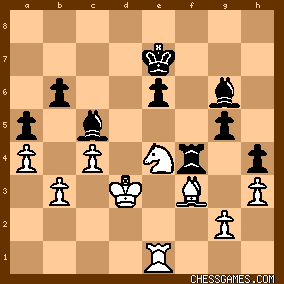
click for larger view
If 55 Kd3 g4, if 56 hxg4 h3, then 57 Rh1.
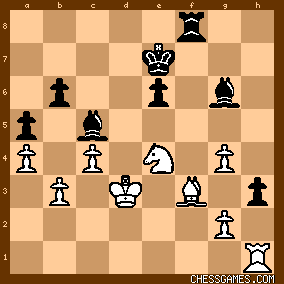
click for larger viewBy playing 54...g4 first, black keeps two rook options. Here is the position after the text 55...h3. 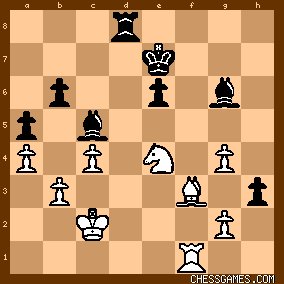
click for larger view
If white plays the text 56 Rd1 black has the text 56...Rf8, etc. If white plays 56 Rh1 instead black has the winning 56...Rd4. 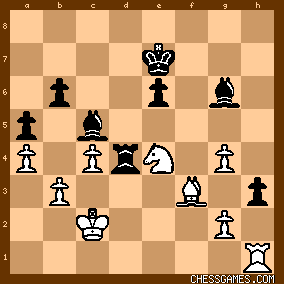
click for larger view |
|
Jan-17-14
 | | ajk68: <Jimfromprovidence>: As I asked above, how does 56...Rd4 win?
57. Rd1 to cover the threat, and 57...h2 fails to g3. |
|
Jan-17-14
 | | Jimfromprovidence: <ajk68> <What does black do if
54... g4 55. hxg4 h3 56. Rh1, ?
If 56...Rd4 57. Rd1 h2 58. g3 and I don't see anything for black.> This is the position.
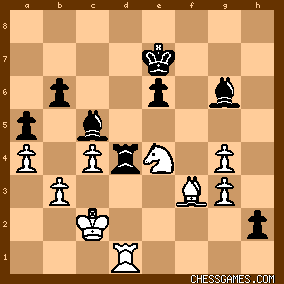
click for larger view Unless I am missing something does not either 58..Rxd4 or 58...Bxd4 work? If 58...Rxe4, I do not see a defense. 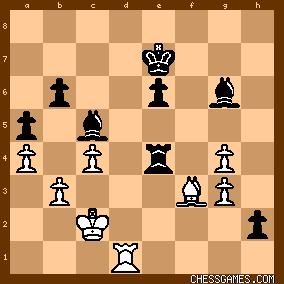
click for larger view |
|
Jan-17-14
 | | ajk68: <Jimfromprovidence> Whoops, meant Re1. |
|
Jan-17-14
 | | Jimfromprovidence: <What does black do if 54... g4 55. hxg4 h3 56. Rh1, ? If 56...Rd4 57. R<e>1 h2 58. g3 and I don't see anything for black.> 58...Bb4!

click for larger viewNow you have overworked pieces. Your rook has to move, losing a piece. Nice thought. |
|
Jan-17-14
 | | ajk68: <jimfromprovidence>: maybe I'm being dense, but Re2 gets the rook to a safe square. The bishop still protects h1. |
|
| Jan-17-14 | | nariga: Why wont this work?
54 ..g4 55.hxg4 h3 56.g3 Rf8? 57.Kd3 |
|
Jan-17-14
 | | ajk68: <nariga>: who are you trying to solve the puzzle for? Why would white play g3 at that point? Rh1 would be stronger. Why do you give Rf8 a question mark? It's black to play in this puzzle. Normally you don't have the solution include dubious moves. |
|
Jan-17-14
 | | ajk68: <nariga>: After 57. Kd3 h2! forcing 58. Ke2, but then 58...Rxf3 59. Kxf3 Bxe4 60. Kxe4 Bg1! and the pawn queens. |
|
| Jan-18-14 | | nariga: <ajk68> my apologies- I am just a novice trying to learn soemthing here. I was trying to see how white can defend himself. Your earlier posts on g3 triggered my thoughts-but as you showed, they dont work. However, what you have posted does seem to work with Re1/Re2 etc. |
|
| Jan-18-14 | | dusk: <ajk68> After 58... Bb4 59. Re2, I believe 59... Bxe4+ wins. 1) 60. Bxe4 Rxe4 61. Rxe4 h8=Q 
2) 60. Rxe4 Rd2+ ... 61... Rf2  |
|
Jan-21-14
 | | ajk68: <dusk>: agreed, except 61...Rf2 should get at least an exclamation point. It is the critical move in the variation. 61...Rf2!! |
|
 |
 |
|
< Earlier Kibitzing · PAGE 3 OF 3 ·
Later Kibitzing> |





